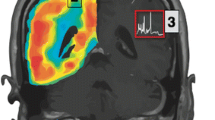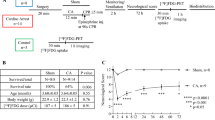Abstract
Background
Microdialysis continuously monitors the chemistry of a small focal volume of the cerebral extracellular space. Positron emission tomography (PET) establishes metabolism of the whole brain but only for the scan’s duration. This study’s objective was to apply these techniques together, in patients with traumatic brain injury, to assess the relationship between microdialysis (extracellular glucose, lactate, pyruvate, and the lactate/pyruvate (L/P) ratio as a marker of anaerobic metabolism) and PET parameters of glucose metabolism using the glucose analogue [18F]-fluorodeoxyglucose (FDG). In particular, we aimed to determine the fate of glucose in terms of differential metabolism to pyruvate and lactate.
Materials and methods
Microdialysis catheters (CMA70 or CMA71) were inserted into the cerebral cortex of 17 patients with major head injury. Microdialysis was performed during FDG-PET scans with regions of interest for PET analysis defined by the location of the gold-tipped microdialysis catheter. Microdialysate analysis was performed on a CMA600 analyser.
Findings
There was significant linear relationship between the PET-derived parameter of glucose metabolism (regional cerebral metabolic rate of glucose; CMRglc) and levels of lactate (r = 0.778, p < 0.0001) and pyruvate (r = 0.799, p < 0.0001), but not with the L/P ratio.
Conclusion
The results suggest that in this population of patients, glucose was metabolised to both lactate and pyruvate, but was not associated with an increase in the L/P ratio. This suggests an increase in glucose metabolism to both lactate and pyruvate, as opposed to a shift towards anaerobic metabolism.


Similar content being viewed by others
References
Archer DP, Elphinstone MG, Pappius HM (1990) The effect of pentobarbital and isoflurane on glucose metabolism in thermally injured rat brain. J Cereb Blood Flow Metab 10:624–630
Bartnik BL, Sutton RL, Fukushima M, Harris NG, Hovda DA, Lee SM (2005) Upregulation of pentose phosphate pathway and preservation of tricarboxylic acid cycle flux after experimental brain injury. J Neurotrauma 22:1052–1065
Bartnik BL, Hovda DA, Lee PW (2007a) Glucose metabolism after traumatic brain injury: estimation of pyruvate carboxylase and pyruvate dehydrogenase flux by mass isotopomer analysis. J Neurotrauma 24:181–194
Bartnik BL, Lee SM, Hovda DA, Sutton RL (2007b) The fate of glucose during the period of decreased metabolism after fluid percussion injury: a 13C NMR study. J Neurotrauma 24:1079–1092
Bellander BM Cantais E, Enblad P, Hutchinson P, Nordstrom CH, Robertson C, Sahuquillo J, Smith M, Stocchetti N, Ungerstedt U, Unterberg A, Olsen NV (2004) Consensus meeting on microdialysis in neurointensive care. Intensive Care Med 30:2166–2169
Bergsneider M, Hovda DA, Shalmon E, Kelly DF, Vespa PM, Martin NA, Phelps ME, McArthur DL, Caron MJ, Kraus JF, Becker DP (1997) Cerebral hyperglycolysis following severe traumatic brain injury in humans: a positron emission tomography study. J Neurosurg 86:241–251
Bullock R, Zauner A, Woodward JJ, Myseros J, Choi SC, Ward JD, Marmarou A, Young HF (1998) Factors affecting excitatory amino acid release following severe human head injury. J Neurosurg 89:507–518
Coles JP, Fryer TD, Smielewski P, Chatfield DA, Steiner LA, Johnston AJ, Downey SP, Williams GB, Aigbirhio F, Hutchinson PJ, Rice K, Carpenter TA, Clark JC, Pickard JD, Menon DK (2004) Incidence and mechanisms of cerebral ischemia in early clinical head injury. J Cereb Blood Flow Metab 24:202–211
Dohmen C, Kumura E, Rosner G, Heiss WD, Graf R (2005) Extracellular correlates of glutamate toxicity in short-term cerebral ischemia and reperfusion: a direct in vivo comparison between white and gray matter. Brain Res 1037:43–51
Dusick JR, Glenn TC, Lee WN, Vespa PM, Kelly DF, Lee SM, Hovda DA, Martin NA (2007) Increased pentose phosphate pathway flux after clinical traumatic brain injury: a [1,2-13C2]glucose labeling study in humans. J Cereb Blood Flow Metab 27:1593–1602
Editorial (1992) Microdialysis. Lancet 339:1326–1327
Enblad P, Valtysson J, Andersson J, Lilja A, Valind S, Antoni G, Langstrom B, Hillered L, Persson L (1996) Simultaneous intracerebral microdialysis and positron emission tomography in the detection of ischemia in patients with subarachnoid hemorrhage. J Cereb Blood Flow Metab 16:637–644
Engström M, Polito A, Reinstrup P, Romner B, Ryding E, Ungerstedt U, Nordström CH (2005) Intracerebral microdialysis in severe brain trauma: the importance of catheter location. J Neurosurg 102:460–469
Feng D, Ho D, Chen K, Wu L-C, Wang J-K, Liu R-S, Yeh S-H (1995) An evaluation of the algorithms for determining local cerebral metabolic rates of glucose using positron emission tomography dynamic data. IEEE Trans Med Imag 14:697–710
Hattori N, Huang SC, Wu HM, Yeh E, Glenn TC, Vespa PM, McArthur D, Phelps ME, Hovda DA, Bergsneider M (2003) Correlation of regional metabolic rates of glucose with Glasgow Coma Scale after traumatic brain injury. J Nucl Med 44:1709–1716
Hillered L, Vespa PM, Hovda DA (2005) Translational neurochemical research in acute human brain injury: the current status and potential future for cerebral microdialysis. J Neurotrauma 22:3–41
Hillered L, Persson L, Nilsson P, Ronne-Engstrom E, Enblad P (2006) Continuous monitoring of cerebral metabolism in traumatic brain injury: a focus on cerebral microdialysis. Curr Opin Crit Care 12:112–118
Hlatky R, Valadka AB, Goodman JC, Contant CF, Robertson CS (2004) Patterns of energy substrates during ischemia measured in the brain by microdialysis. J Neurotrauma 21:894–906
Huang SC, Phelps ME, Hoffman EJ, Sideris K, Selin CJ, Kuhl DE (1980) Noninvasive determination of local cerebral metabolic rate of glucose in man. Am J Physiol 238:E69–E82
Hutchinson PJ, Hutchinson DB, Barr RH, Burgess F, Kirkpatrick PJ, Pickard JD (2000) A new cranial access device for cerebral monitoring. Br J Neurosurg 14:46–48
Hutchinson PJ, Gupta AK, Fryer TF, Al-Rawi PG, Chatfield DA, Coles JP, O’Connell MT, Kett-White R, Minhas PS, Aigbirhio FI, Clark JC, Kirkpatrick PJ, Menon DK, Pickard JD (2002) Correlation between cerebral blood flow, substrate delivery, and metabolism in head injury: a combined microdialysis and triple oxygen positron emission tomography study. J Cereb Blood Flow Metab 22:735–745
Hutchinson PJ, O’Connell MT, Nortje J, Smith P, Al-Rawi PG, Gupta AK, Menon DK, Pickard JD (2005) Cerebral microdialysis methodology—evaluation of 20 kDa and 100 kDa catheters. Physiol Meas 26:423–428
Kinahan PE, Rogers JG (1989) Analytic 3D image reconstruction using all detected events. IEEE Trans Nucl Sci 36:964–968
Lammertsma AA, Brooks DJ, Frackowiak RS, Beaney RP, Herold S, Heather JD, Palmer AJ, Jones T (1987) Measurement of glucose utilisation with [18F]2-fluoro-2-deoxy-D-glucose: a comparison of different analytical methods. J Cereb Blood Flow Metab 7:161–172
Lee JY, Kim YH, Koh JY (2001) Protection by pyruvate against transient forebrain ischemia in rats. J Neurosci 21:RC71
Manning Fox JE, Meredith D, Halestrap AP (2000) Characterisation of human monocarboxylate transporter 4 substantiates its role in lactic acid efflux from skeletal muscle. J Physiol 529:285–293
McKenna MC, Waagpetersen HS, Schousboe A, Sonnewald U (2006) Neuronal and astrocytic shuttle mechanisms for cytosolic-mitochondrial transfer of reducing equivalents: current evidence and pharmacological tools. Biochem Pharmacol 71:399–407
Menon DK (1999) Cerebral protection in severe brain injury: physiological determinants of outcome and their optimisation. Br Med Bull 55:226–258
Moncada S, Bolanos JP (2006) Nitric oxide, cell bioenergetics and neurodegeneration. J Neurochem 97:1676–1689
Noske DP, Peerdeman SM, Comans EF, Dirven CM, Knol DL, Girbes AR, Vandertop WP (2005) Cerebral microdialysis and positron emission tomography after surgery for aneurysmal subarachnoid hemorrhage in grade I patients. Surg Neurol 64:109–115
O’Connell MT, Seal A, Nortje J, Al-Rawi PG, Coles JP, Fryer TD, Menon DK, Pickard JD, Hutchinson PJ (2005) Glucose metabolism in traumatic brain injury: a combined microdialysis and [18F]-2-fluoro-2-deoxy-D-glucose-positron emission tomography (FDG-PET) study. Acta Neurochir Suppl 95:165–168
Patlak CS, Blasberg RG, Fenstermacher JD (1983) Graphical evaluation of blood-to-brain transfer constants from multiple-time uptake data. J Cereb Blood Flow Metab 3:1–7
Pellerin L, Magistretti PJ (1994) Glutamate uptake into astrocytes stimulates aerobic glycolysis: a mechanism coupling neuronal activity to glucose utilization. Proc Natl Acad Sci U S A 91:10625–10629
Pellerin L (2003) Lactate as a pivotal element in neuron-glia metabolic co-operation. Neurochem Int 43:331–338
Persson L, Hillered L (1992) Chemical monitoring of neurosurgical intensive care patients using intracerebral microdialysis. J Neurosurg 76:72–80
Pierre K, Pellerin L (2005) Monocarboxylate transporters in the central nervous system: distribution, regulation and function. J Neurochem 94:1–14
Reinstrup P, Ståhl N, Mellergård P, Uski T, Ungerstedt U, Nordström CH (2000) Intracerebral microdialysis in clinical practice: baseline values for chemical markers during wakefulness, anesthesia, and neurosurgery. Neurosurgery 47:701–709
Samuelsson C, Hillered L, Zetterling M, Enblad P, Hesselager G, Ryttlefors M, Kumlien E, Lewén A, Marklund N, Nilsson P, Salci K, Ronne-Engström E (2007) Cerebral glutamine and glutamate levels in relation to compromised energy metabolism: a microdialysis study in subarachnoid hemorrhage patients. J Cereb Blood Flow Metab 27:1309–1317
Shulman RG, Rothman DL, Hyder F (1999) Stimulated changes in localized cerebral energy consumption under anesthesia. Proc Natl Acad Sci U S A 96:3245–3250
Simpson IA, Carruthers A, Vannucci SJ (2007) Supply and demand in cerebral energy metabolism: the role of nutrient transporters. J Cereb Blood Flow Metab 27:1766–1791
Spanaki MV, Siegel H, Kopylev L, Fazilat S, Dean A, Liow K, Ben-Menachem E, Gaillard WD, Theodore WH (1999) The effect of vigabatrin (gamma-vinyl GABA) on cerebral blood flow and metabolism. Neurology 53:1518–1522
Ungerstedt U (1991) Microdialysis-principles and applications for studies in animals and man. J Intern Med 230:365–373
Vespa P, Bergsneider M, Hattori N, Wu HM, Huang SC, Martin NA, Glenn TC, McArthur DL, Hovda DA (2005) Metabolic crisis without brain ischemia is common after traumatic brain injury: a combined microdialysis and positron emission tomography study. J Cereb Blood Flow Metab 25:763–774
Acknowledgements
We gratefully acknowledge the following. Study support: the Medical Research Council (Grant No G9439390 ID 65883) and the Academy of Medical Sciences / Health Foundation. Authors’ support: KLHC, the MRC (Acute Brain Injury Programme Grant) and the National Institute for Health Research Biomedical Research Centre, Cambridge. IT, Codman and the Evelyn Trust; PGA, the Stroke Association, UK; PJH, Academy of Medical Sciences / Health Foundation Senior Surgical Scientist Fellowship. Technical assistance: L Maskell. Statistical advice: H Richards.
Author information
Authors and Affiliations
Corresponding author
Additional information
Comment
This manuscript reports extracellular neurochemical data collected during metabolic imaging studies using cerebral microdialysis and positron emission tomography (PET) respectively in severely head-injured patients. From the comparisons of these two types of measurements, the authors concluded that the rates of cerebral glucose metabolism had a significant linear relationship with extracellular concentrations of lactate and pyruvate. However, the degree of cerebral glycolysis was not related to the extracellular lactate/pyruvate ratio suggesting that anaerobic metabolism was not a major feature in these subjects.
David Hovda
UCLA, USA
Rights and permissions
About this article
Cite this article
Hutchinson, P.J., O’Connell, M.T., Seal, A. et al. A combined microdialysis and FDG-PET study of glucose metabolism in head injury. Acta Neurochir (Wien) 151, 51–61 (2009). https://doi.org/10.1007/s00701-008-0169-1
Received:
Accepted:
Published:
Issue Date:
DOI: https://doi.org/10.1007/s00701-008-0169-1




